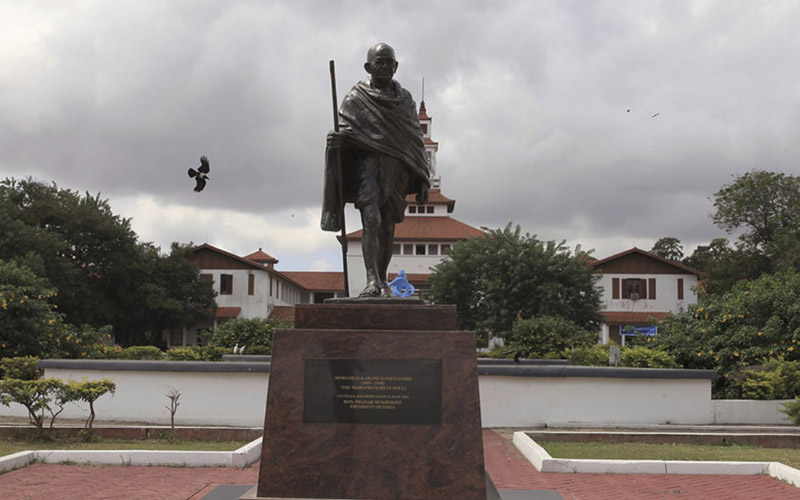The government of Ghana has announced that a statue of Mahatma Gandhi will be removed from its position on the campus of the University of Ghana in Accra after it finally dawned on them that the Indian leader, far from being a “champion of harmony,” was in fact a virulent anti-black racist.
The statue will be removed from its prominent position to a “place of safety,” only a few months after it was unveiled by the Indian President, Shri Prenab Mukhereje, during his state visit to Ghana last year.

The Ghana government statement said that “Mahatma Gandhi may have had his flaws,” and urged “Ghanaians to look beyond the comments attributed to Mahatma Gandhi and acknowledge his role as one of the most outstanding personalities of the last century who demonstrated that non-violent [sic].” (The statement, issued by the Ministry of Foreign Affairs and Regional Integration, ends there, without further explanation.)
The brouhaha started when a group of lecturers and students began campaigning for the Indian nationalist leader’s statue to be removed, saying that Gandhi made comments “that were racist about Africans and that statues on the Accra campus should be of African heroes.”
There is truth in their allegations that Gandhi despised blacks. For example, when he addressed a public meeting in Bombay on September 26, 1896, he had the following to say about the Indian struggle in South Africa:
“Ours is one continued struggle against degradation sought to be inflicted upon us by the European, who desire to degrade us to the level of the raw kaffir, whose occupation is hunting and whose sole ambition is to collect a certain number of cattle to buy a wife with, and then pass his life in indolence and nakedness” (The Collected Works of Mahatma Gandhi, Vol. II, Ahmedabad, 1963, p. 74).
In 1904, when commenting on a piece of legislation planned by the white Natal Municipal authority, called the Natal Municipal Corporation Bill, Gandhi wrote in his newspaper, the Indian Opinion, on March 18, 1905:
“Clause 200 makes provision for registration of persons belonging to uncivilized races, resident and employed within the Borough. One can understand the necessity of registration of kaffirs who will not work, but why should registration be required for indentured Indians who have become free, and for their descendants about whom the general complaint is that they work too much?” (The Collected Works of Mahatma Gandhi, Vol. IV, Ahmedabad, 1963, p. 193).
The Indian Opinion was Gandhi’s own newspaper, and in an editorial he penned which was published on September 9, 1905 under the heading, “The Relative Value of the Natives and the Indians in Natal,” Gandhi referred to a speech made by Rev. Dube, an early African nationalist, who said that an African had the capacity for improvement, if only the whites would give them the opportunity.
In his response, Gandhi suggested that:
“A little judicious extra taxation would do no harm; in the majority of cases it compels the native to work for at least a few days a year” (MK Gandhi, Indian Opinion, March 18, 1905).
Then he added:
“Now let us turn our attention to another and entirely unrepresented community—the Indian. He is in striking contrast with the native. While the native has been of little benefit to the State, it owes its prosperity largely to the Indians. While native loafers abound on every side, that species of humanity is almost unknown among Indians here.”
In a letter to the editor of the Times of London, published in November 12, 1906, Gandhi complained that under British rule, “kaffir police” were “hustling” Indians in South Africa. Gandhi wrote:
“Poor people were, under the registration effected by Lord Milner’s advice, dragged at four o’clock on a cold winter’s morning—from their beds in Johannesburg, Heidelberg, and Potchefstroom, and marched to the police station, or Asiatic Offices, as the case might be. It is they who under the Ordinance would be hustled by the kaffir police at every turn, and not the better-class Indians” (MK Gandhi, Letter to the Times, London, November, 12, 1906).
In the Hollywood film made about Gandhi, much emphasis was placed on a scene where he was arrested for riding in a South African train coach reserved for whites. This incident did indeed occur, but for very different reasons than those the film portrayed.
It is claimed that Gandhi was protesting the exclusion of nonwhites from the train coach: in fact, he was trying to persuade the authorities to let only upper caste Indians ride with the whites. It was in fact never Gandhi’s intention to let blacks, or even lower caste Indians, share the white compartment.
Here, in Gandhi’s own words, are his comments on this famous incident, complete with reference to upper caste Indians, who he differentiated from lower caste Indians by calling the former “clean”:
“You say that the magistrate’s decision is unsatisfactory because it would enable a person, however unclean, to travel by a tram, and that even the kaffirs would be able to do so. But the magistrate’s decision is quite different. The Court declared that the kaffirs have no legal right to travel by tram. And according to tram regulations, those in an unclean dress or in a drunken state are prohibited from boarding a tram. Thanks to the Court’s decision, only clean Indians or coloured people other than kaffirs, can now travel in the trams” (MK Gandhi, Indian Opinion, June 2, 1906).
The Ghanaians are therefore completely accurate in their objections to Gandhi’s statue standing in Accra—doubtless he himself would also object.